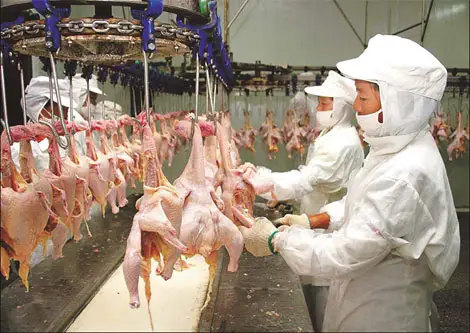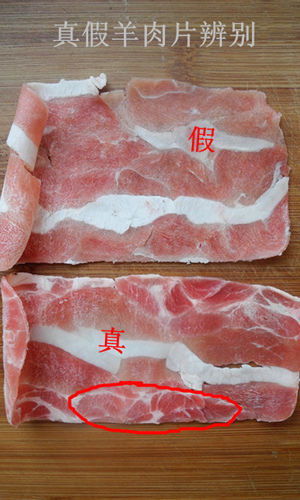
Unlabeled Chinese chicken imports to the U.S. may be on the rise thanks to a newly-reached trade deal. Photo via China Daily
A story that Port of San Francisco customs seized 300,000 pounds of rat meat to be sold across the U.S. as chicken meat has been circling around since at least 2016.
But a year later, it suddenly went viral, and a few websites claimed that the FDA issued a warning about 1,000,000 pounds of rat meat that could be circulating around the country and even infiltrating your Super Bowl feast.
The website that the story might have originated on urbanimagemagazine.com no longer seems to be accessible.
As of right now, there is no real evidence that this rat meat confiscation took place. The questions are: if this were to happen, would customs even notice? And if they did, would they ever tell the public?
Hidden in this questionable story are real concerns, exasperated by a new ruling that could make unlabeled and uninspected chicken and other meat from China more commonplace than ever.
Here is what you must know before your next meat purchase.
Fake Meat Scandals Are a Serious Concern in China

Fake lamb above has a very pronounced separation between white and red parts of the meat. It falls apart easy. PHOTO: blog.163.com
In 2013, one of China’s many food scandals was Chinese police catching traders who sold rat, fox, and mink meat (which was never inspected) as mutton, reported The New York Times. The 20,000 tons of fake mutton meat was mixed with gelatin, red pigment, and nitrates, and was worth $1.6 million.
That year, at least 904 people were arrested in China for selling fake or adulterated meats, and over 1,721 illicit factories and shops were broken up in the country.
The meat these people were selling included items injected with water and meat from previously diseased animals.
“The United States and Europe can’t eradicate these problems, either, but they are even more complicated in China,” said Professor Mao Shoulong at Renmin University, Beijing.
Chinese food problems do not originate in just the meat industry. The list of potential fake foods from scammers is long, and includes items such as chemical imitation eggs, mud-based “black pepper”, corn “potato noodles,” and plastic rice. (Read: Top 10 Toxic Fake Food Items Produced In China)
Can these fake foods make it to the U.S.?
There Are 87 Import Alerts from China – The Most of All Countries
All import alerts can be accessed on the FDA’s website. Right now, there are 87 alerts posted about imports from China. This number is followed by 72 from Mexico, 67 from Canada, 57 from India, and 52 from Hong Kong.
Most of the alerts about China are from 2017, and a few are from as early as 2011.
Food items that have been seized are:
Duck eggs (due to presence of lead)
Dried shark fins (filth)
Seafood (due to mislabeling, unsafe food additives, unapproved drugs such as antibiotics, bacteria, and decomposing)
Frog legs
Dried fruits (lead)
Fruit juices (heavy metal contamination)
Dates (filth)
Melon seeds
Dried mushrooms (filth)
Garlic (mold)
Candy (lead)
Honey (unsafe drug residues)
Stevia
Dried plantain (other plant contamination)
Poultry jerky (antibiotics)
Other food products (illegal sweeteners)
Dietary supplements (active pharmaceutical ingredients, lead, arsenic, mercury, cadmium)
Chinese herbal medicines
Pharmaceuticals (unapproved)
Human Growth Hormone (also known as HGH)
Animal drugs (unapproved)
Animal foods (Salmonella and chemicals)
Kitchenware (lead and cadmium)
Cosmetics (microbiological contamination)
Temporary tattoos (illegal color additives)
Various other non-food items (microbiological contamination, unapproved, defects, and mislabeling)
These seized items come from a very small percentage of foods that have been inspected. Many fake or contaminated foods can therefore end up on U.S. shelves.
Not even an organic label can prevent that from happening as up to 80% of all organic foods are imported. (Read: Fake “Organic” Food From China is FLOODING Store Shelves.)
Imported Chinese Meat Totals Expected to Rise
Unfortunately for people who enjoy buying meat from the grocery store, the likelihood of purchasing a meat product from China, especially in the case of poultry, has also been on the rise recently.
A May 2017 report from NPR detailed a massive new trade deal that opened up the Chinese beef market for U.S. exporters in exchange for increased access to U.S. customers for Chinese chicken producers.
Considering that country-of-origin labeling was revoked in 2016 and foreign meat can be sold without labeling in the United States (a new lawsuit is challenging the ruling), you could very well be eating meat or poultry from China right now without even knowing it, especially if you buy “conventional” meat products.
Eating imported Chinese meat may be a risky proposition, considering the roughly 500,000 cases of food safety violations recorded in the country in the first three quarters of 2016 alone.
The FDA Inspects Only a Small Number of Foods Coming from Overseas
In 2008, the FDA admitted that its own staffing issue makes it impossible to inspect every item coming from overseas. This includes drugs, medical devices, and food. It would take 1,900 years to examine every foreign food plant.
Over the years this problem has led to deadly pet food and contaminated spinach reaching and endangering U.S. consumers.
“How many more examples are needed to demonstrate that this agency is struggling and the public health is at risk?” asked former Michigan Representative John D. Dingell.
Inspections of food from overseas have greatly declined over the years, adding to the chances of buying a contaminated product.
In 1973, the FDA handled 34,919 food inspections, but in 2006 – only 7,783. The number of import inspectors also dropped from 531 in 2003 to 380 in 2006.
The following year it was calculated that only 1.3% of imported foods are inspected, reported USA Today.
Meanwhile, the number of imported goods grows by millions each year, and reached 36,000,000 products in 2016.
When a small number of them do get inspected, many shipments are seized due to contamination: such as catfish from China, blackberries from Guatemala, jalapenos from Peru, beans from Belgium and more.
Unfortunately, since our food safety institutions don’t seem to realize the gravity of the problems being caused by Chinese and other uninspected imports, the one real solution for avoiding possible contaminations is to know your farmer and food makers, and to buy as local as possible (or grow your own food).
The smaller the food and more local the food producer is, the fewer hands the food goes through before ending up on your plate, and therefore, the less chance of contamination.
At any rate, it’s certainly better than buying food imported from countries thousands of miles away like China, where lax regulations and little accountability are a dream for producers, and a potential nightmare for consumers.
Recommended reading:
Fake “Organic” Food From China is FLOODING Store Shelves. Here’s What You Need to Know
Top 10 Toxic Fake Food Items Produced In China
This article was first published in August 2017 and updated again in July 2018. For more articles like these in your inbox (and a free eBook), you can sign up here.
Thanks for installing the Bottom of every post plugin by Corey Salzano. Contact me if you need custom WordPress plugins or website design.




